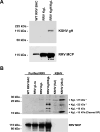Generation of chimeric forms of rhesus macaque rhadinovirus expressing KSHV envelope glycoproteins gH and gL for utilization in an NHP model of infection
- PMID: 39835812
- PMCID: PMC11852781
- DOI: 10.1128/jvi.01923-24
Generation of chimeric forms of rhesus macaque rhadinovirus expressing KSHV envelope glycoproteins gH and gL for utilization in an NHP model of infection
Abstract
Kaposi's sarcoma-associated herpesvirus (KSHV) is a human gammaherpesvirus associated with Kaposi's sarcoma and B cell malignancies. Like all herpesviruses, KSHV contains conserved envelope glycoproteins (gps) involved in virus binding, entry, assembly, and release from infected cells, which are also targets of the immune response. Due to the lack of a reproducible animal model of KSHV infection, the precise functions of the KSHV gps during infection in vivo are not completely known. Fortunately, a nonhuman primate (NHP) model of KSHV infection and disease has been established utilizing closely related rhesus macaque rhadinovirus (RRV) that naturally infects rhesus macaques (RM) and possesses analogous gps to KSHV. To address the roles conserved envelope gps gH and gL play during KSHV infection in vivo, we utilized the pathogenic RRV17577 BAC to generate chimeric forms of RRV expressing KSHV gL or KSHV gH/gL, as well as an RRV mutant lacking gL expression. These viruses incorporate KSHV gH and gL into infectious virions, and although they display variable replication and differing plaque phenotypes in primary rhesus fibroblasts, they retain the ability to infect human B cells in vitro. Importantly, we also demonstrate that RRV gp chimeras can infect RM and induce the development of antibodies against KSHV. Overall, this work demonstrates that RRV gp chimeras can serve as important tools to assess the role of KSHV gH/gL in infection and disease while also providing an NHP model for testing the efficacy of KSHV gH and gL neutralizing antibodies and vaccine strategies to prevent and treat KSHV infection.IMPORTANCERhesus macaque rhadinovirus (RRV) is a rhesus macaque homolog of KSHV and serves as a model system for examining Kaposi's sarcoma-associated herpesvirus (KSHV) infection and pathogenesis in vivo. KSHV and RRV both encode conserved herpesvirus envelope glycoproteins, including gH and gL, that are important for regulating entry into host cells. In this study, we utilized the RRV BAC system to generate chimeric forms of RRV expressing KSHV gH and gL, as well as a mutant form of RRV lacking gL expression. Although these mutant and chimeric viruses can replicate in vitro, they do display growth properties different from wild-type RRV. Importantly, we demonstrate that RRV gp chimeras are capable of infecting rhesus macaques in vivo, inducing B cell hyperplasia, and promoting the development of anti-viral antibody responses that can also recognize KSHV antigens. RRV gp chimeras provide a novel system that allows for the examination of the role of KSHV gH and gL during infection in vivo.
Keywords: Kaposi's sarcoma-associated herpesvirus; RRV BAC; chimeric virus; glycoproteins; rhesus rhadinovirus; vaccines.
Conflict of interest statement
The authors declare no conflict of interest.
Figures








Similar articles
-
Glycoproteins gM and gN are indispensable factors for rhesus macaque rhadinovirus replication and spread but can be reconstituted by KSHV chimeras.J Virol. 2025 Mar 18;99(3):e0192224. doi: 10.1128/jvi.01922-24. Epub 2025 Feb 25. J Virol. 2025. PMID: 39998253 Free PMC article.
-
BALB/c mice immunized with a combination of virus-like particles incorporating Kaposi sarcoma-associated herpesvirus (KSHV) envelope glycoproteins gpK8.1, gB, and gH/gL induced comparable serum neutralizing antibody activity to UV-inactivated KSHV.Oncotarget. 2017 May 23;8(21):34481-34497. doi: 10.18632/oncotarget.15605. Oncotarget. 2017. PMID: 28404899 Free PMC article.
-
The Kaposi's Sarcoma-Associated Herpesvirus (KSHV) gH/gL Complex Is the Predominant Neutralizing Antigenic Determinant in KSHV-Infected Individuals.Viruses. 2020 Feb 26;12(3):256. doi: 10.3390/v12030256. Viruses. 2020. PMID: 32111001 Free PMC article.
-
Rhesus macaque rhadinovirus-associated disease.Curr Opin Virol. 2013 Jun;3(3):245-50. doi: 10.1016/j.coviro.2013.05.016. Epub 2013 Jun 6. Curr Opin Virol. 2013. PMID: 23747119 Free PMC article. Review.
-
The Black Book of Psychotropic Dosing and Monitoring.Psychopharmacol Bull. 2024 Jul 8;54(3):8-59. Psychopharmacol Bull. 2024. PMID: 38993656 Free PMC article. Review.
References
-
- Oksenhendler E, Boulanger E, Galicier L, Du MQ, Dupin N, Diss TC, Hamoudi R, Daniel MT, Agbalika F, Boshoff C, Clauvel JP, Isaacson PG, Meignin V. 2002. High incidence of Kaposi sarcoma-associated herpesvirus-related non-Hodgkin lymphoma in patients with HIV infection and multicentric Castleman disease. Blood 99:2331–2336. doi:10.1182/blood.v99.7.2331 - DOI - PubMed
-
- Soulier J, Grollet L, Oksenhendler E, Cacoub P, Cazals-Hatem D, Babinet P, d’Agay MF, Clauvel JP, Raphael M, Degos L. 1995. Kaposi’s sarcoma-associated herpesvirus-like DNA sequences in multicentric Castleman’s disease. Blood 86:1276–1280. doi:10.1182/blood.V86.4.1276.bloodjournal8641276 - DOI - PubMed
MeSH terms
Substances
Grants and funding
LinkOut - more resources
Full Text Sources
Molecular Biology Databases

